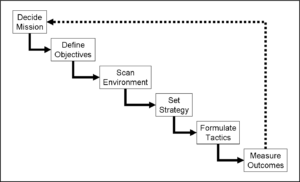Deciding a strategy for a business is very much important for growth and stability. You not only need to focus on the performance but you will also need one of the working strategies for your company. There are mainly three operational business strategies (as it applies to IT): reactive IT strategy, proactive IT strategy, and the last is strategic IT. We are going to see all these three things in brief and see a detailed comparison of Reactive vs Proactive vs Strategic IT.
Overview of Reactive vs Proactive vs Strategic IT
Before we can compare all three IT strategies, let’s understand all three of them. Thereafter, you can choose the best IT strategy for your business.
Reactive IT strategy is where you take the steps once the damage has been done. In other words, you wait till the system crashes and when the system crashes, you can call the tech consulting company and wait for them to make it live again. Similarly, IT waits for the business to request something new, and then reacts. Reactive IT strategy was one of the most used strategies in previous days, assuming the business knew exactly what was needed, and IT was the ones who executed the technical aspects. However, people are now switching to a proactive strategy.
A proactive strategy is where constant monitoring is done on the system to prevent it from crashing. In other words, the team is constantly monitoring the servers to make sure it doesn’t crash. Of course, system failure is just an example we are using. Many things are monitored in a proactive strategy, but it can only get you so far since it assumes that where you are today is exactly where you want to be.
You surely might be wondering what if reactive is after the disaster and proactive is to prevent the disaster then what’s strategic IT, right?
Well, it’s different from both of them.
Strategic IT support is where you plan all the technical things ahead of time. No doubt, proactive IT support is great, but you want to rely on the ticketing system and forget about the performance, speed, and delivering a better experience for your customers? Well, strategic IT support will include all of those things such as planning for the growth and delivering a better experience for your customers.
Failure was, of course, an example here. It could be any set of events.
So, which strategic IT is better?
You are here for the comparison of Reactive vs Proactive vs Strategic IT, right? I won’t waste much of your time in showing the details and keeping you in the loop.
Let me be crystal clear and tell you which one is better.
Reactive is bad, Proactive is good, and Strategic IT is the one you should be following.
How can I directly say this? I already have a full article explaining why it’s so. You can check it out here. It’s focused on the technical part. So, if you are more interested in knowing the whole comparison from a technical point of view, you should check that article.
Let’s talk business here.
A reactive plan will use the same set of actions that are already available on your plan. In other words, here we will only work on the events that are already occurred. In other words, the planning starts once the situation arises. It is a time-consuming process and it will take months to recover from the situation. Hence, we can say it’s worst.
Proactive planning is where you create a future stage and then work with the plan to reach the stage. It also involved monitoring the current plans and it’s the outcome. It’s good but not the best. When you try to use proactive planning or proactive strategy in your business, you will end up messing up things (more on it later).
So, it’s always a better option to have everything pre-planned. Strategic planning is the process of documenting and creating a complete roadmap for your business. It includes all the things such as the growth of your business, innovation, etc.
This was to let you know about the basic concept and the actual definition of the three strategies. Now, let’s start the real article and see the technical things to compare Reactive vs Proactive vs Strategic IT.
Let’s get technical now
As technology is going bigger and bigger, tools like Microsoft’s Power Apps and Power BI are giving more access to the people. Now, even a citizen developer and work on it without having to wait for the IT support.
Agile and DevOps are mostly used by most of the companies. Many companies try to incorporate the same ideas to make it proactive. No doubt, it will look proactive but in reality, it’s just reactive strategy (just a bit faster than regular reactive support).
The solution given here will never work together. For instance, if you use ad-hoc and then start pulling the data from different sources, it will never work and you will end up messing the entire system.
The developer surely knows about how it works and what to do next. But what if they leave for some reason? It’s difficult to get IT to support after it.
So, you need to be strategic instead of just being proactive.
Strategic IT includes some of the important things that you should be considering for your business. It’s not only about prioritizing meetings and stuff like that. It’s about making a complete roadmap for your business IT growth.
Planning out the roadmap
There should be a proper plan for your business. This particular roadmap is all about making financial goals. You need to have a proper working plan for where your company will stand in the future. This will include all the ideas and financial funds in mind.
Executives nowadays keep their primary idea in front of people to get funding. It works, they also get the funding but when you see the long-term game, you need a proper strategy to make sure you meet the demands of the IT. A small example will be to work in a team. All of the executives have their amazing idea. If all of them are put together to solve the problem, it will not only get proper funding but it will also help the growth of the company.
So, it’s necessary to have a strategic financial roadmap for the business.
Lastly, it’s not only about creating a financial roadmap, but you also need to have a complete plan on what works and what doesn’t. Whether it’s about ideas, growth, innovation, or something else. You need to focus on the plan to make sure you can achieve what needs to be achieved.
Understand IT support and Business support
Reactive vs Proactive vs Strategic IT are the three different terms that can be used anywhere. People not only use it in IT support but also when you take the business consulting into consideration, the same terms are used.
In simpler words, whether it’s about planning a future for your business or planning the IT support for your business, the same terms are used.
So, you might be wondering what you need to focus on? Whether it’s IT or the business solution?
Well, the answer here is both.
I always say, IT and business not just aligned, but fused.
In other words, if you focus on both the things together, you can easily achieve great heights.
One of our guides shows how a transformation can save you from the pandemic.
We discussed many things here. Whether it’s about IT or it’s about the business. The conclusion was the same. You need to focus on both the things together to see the results. IT will create a foundation for you and the business support will help you reach the goals of your business.
When you mix it, your business will see huge growth.
One of the good examples here can be pandemic. No one was prepared for the pandemic. However, a complete transformation of business can save your business from pandemic (even from COVID-19).
Why strategic IT is the best choice for your business?
No matter what your business model is, if you want to choose the best from Reactive vs Proactive vs Strategic IT, you should always go with the strategic IT. Here are some of the reasons why.
To make the guide easy to understand, let’s see a point by point reasons on why you should always choose Strategic IT.
- You have a direction. Your business is not just surviving but growing
- The primary focus is on growth and innovation. Both of them will bring more revenue in the end. As a result, your business will grow.
- You have complete documentation of what you are doing. You can change the plan anytime you want.
- Also, you are safe from all types of crisis or disaster as you have complete proper planning of what you should do next.
- It gives a goal, an aim, and a mission for you and your employees. Unlike proactive planning, it’s not about saving the business from drowning but about growing the business.
- It increases customer satisfaction.
- Strategic planning also helps you in decreasing the communication gap between your employees. A strategic IT plan includes meetings not only with the executives but also with the customers. So, your employees can also communicate and give their opinion. Involving your employees in the plan will help them work more efficiently which will eventually benefit your company.
These are a couple of reasons why you should go with the strategic IT instead of any other.
However, there are many things that you need to keep in mind while you are choosing the plan. Let’s understand the process of strategic IT to know more about it.
Strategic IT Process
Though how you work with this in your business depends on many factors, in general, there are three main parts of the strategic IT process:
- Analysis
- Development
- Update
The first phase is the analysis phase where the main aim is to collect as much information as we can. It’s a discussion phase where the consulting company will discuss all the details with your business. The main aim here is to create the end goal and to know the current position of your business.
The next phase is the development part where the actual development begins. Here, a complete roadmap is made. Also, the plan is implemented after the finalization.
Once the plan is finalized, you need to update it regularly. It’s not one-time planning. To grow your business, you need to measure the growth of the company and update the plan whenever and wherever possible. It will help you achieve more things faster.
Further, regular meetings, proper communication, reporting, etc are the main things that you need to do in strategic planning.
So, what’s the thing to keep in mind?
Like every other thing, there are some of the important things that you need to keep in mind. This even applies to strategic IT planning. You need to keep in a couple of things to make sure everything goes right.
We will see some of the reasons why this plan fails and what are the measures you can take to stop it from failure.
Just like the steps in the process, there are three main reasons why it fails.
- Not good leadership
- Less communication or meetings
- Not proper planning
Good leadership is a must when you are creating and working on a plan. The next thing is to work together. As I mentioned above, all the executives might have different ideas, the goal here is to work as a team. You need to set regular meetings to discuss the progress and to see the overall growth. The last thing is proper planning. You need proper planning to make any plan success.
If you don’t have proper planning and want a working plan for the growth of your business, I have something for you that might amaze you. I work with my team to consult businesses. I have a huge experience of working with different companies. We keep in mind the IT part as well as the business part which makes our consulting the best one in the market. You can have a look at if you need any kind of guidance for your business.







Recent Comments